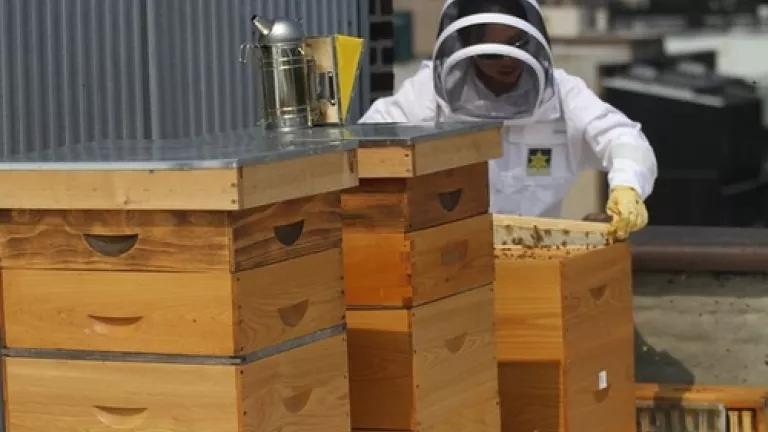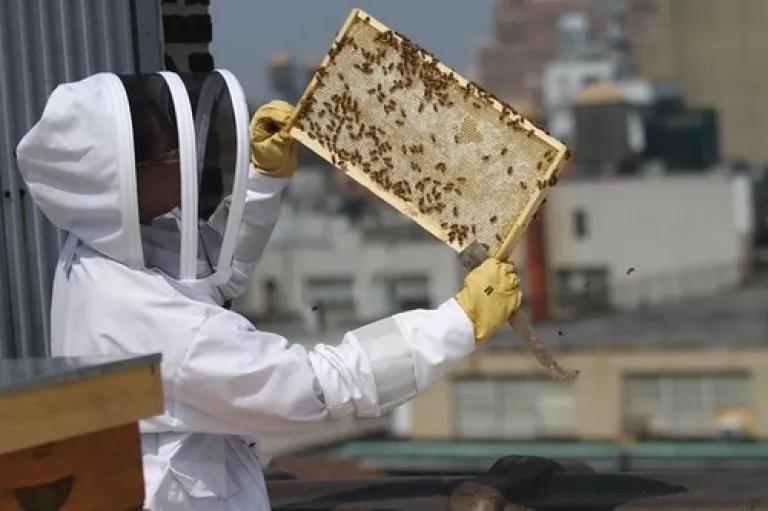
Legal fellow Vivian Wang is today’s guest blogger.
Last month, NRDC took its pollinator campaign to the next level by installing three hives of honeybees on our office rooftop. Since then, our bees have been buzzing around Chelsea, pollinating the flowers and trees in neighboring green roofs and nearby parks.
As Peter explained in his June blog post, my fascination with bees is a result of NRDC’s work to remove a potentially bee-toxic pesticide, spirotetramat, from the market. In the process of reviewing toxicology reports and writing legal briefs, I started to learn about the importance of bees to our ecosystem and the intricate world inside a hive. Bitten by the bug (pun fully intended), I enrolled in the New York City Beekeepers Association winter course on urban beekeeping and spent a few weekends shadowing Andrew Coté, the city’s most seasoned beekeeper, while he worked his hives. Andrew patiently guided me through my first hiving (placing three pounds of bees from a package into their new home) and did not laugh at my surprised yelp when I received my first sting (right below the eye – I started to wear a veil after that).
Photo credit: Matthew Cohen
After beekeeping in New York City was legalized in April, I was eager to join the ranks of beekeepers at NRDC. Science Center director Gaby Chavarria, who was recently appointed science advisor to the Director of Fish and Wildlife Services, kept a hundred hives on her family farm in Mexico. Senior scientist Jen Sass, who works on regulation of toxic chemicals, is a second-year beekeeper in Maryland. And by happy coincidence, Peter’s sister Christine Lehner is a beekeeper in Westchester with Let it Bee Apiaries. Christine also has hives on the Upper East Side and in Harlem, and was excited to branch into Chelsea and partner with NRDC.
Since the arrival of our bees, I have traded in coffee breaks for hive visits. Once a week I don a jacket and veil, light the burlap in my smoker (puffing cool smoke into the hive masks the bees’ alarm pheromone), and pry off the outer cover to peer into a hive humming with activity. Lifting out individual frames, I check for eggs and larvae – signs that the queen bee is healthy – and also for pollen and honey, which are the bees’ sources of protein and carbohydrates. Beekeeping at twelve stories presents interesting challenges. The hives must be strapped down because of the strong gusts of wind at that height. I marvel at the ability of these small insects to stay on course as they leave and enter the hive. These are the highest hives in this city that I know of, and this has been a test for whether beekeeping is viable at these heights. (As an aside, New Yorkers may be surprised at the hidden world of hives on rooftops of restaurants and prep schools).
Thus far, our bees have displayed the characteristic tenacity of New Yorkers. (But unlike most New Yorkers, they enjoy a view of the Empire State Building and are stars on the local evening news). Despite the hot sun and strong winds, the bees have adjusted to their new home and labored diligently, building comb and gathering pollen and nectar. Two weeks ago, we placed honey supers on top of the hives. These shallow boxes provide room for the bees to make extra honey for us. Although we do not have any honey ready for harvest, when I inspected the bees today, I saw many milling about the supers, bringing in nectar from nearby flowers. In order to transform nectar into honey, the bee will repeatedly ingest and regurgitate the nectar until it reaches a desired consistency. The nectar is placed back into the cell and the bees in the hive will fan their wings to evaporate much of the water from the nectar. This raises the sugar concentration and prevents fermentation, which is why ripe honey, if properly sealed, does not spoil. Watching one bee with her head buried inside a hexagonal cell, proboscis extended to deposit the light golden nectar, I marveled at her diligence (one worker bee makes just 1/12 of a teaspoon of honey in her lifetime).

Photo credit: Matthew Cohen
My colleagues have reacted with mixture of bemusement and excitement to the news of the NRDC bees. A week after we installed the hives, I received a phone call from our litigation director, Mitch Bernard. I grabbed a pad of paper before entering his office, expecting to delve into research related to the Gulf oil spill or our pesticides litigation. Instead, he smiled and gestured toward his window. Dozens of bees were swooping around just outside, casting tiny moving shadows in his office. Watching their aerial dance, I was reminded of the myriad ways in which we are always a part of nature, even in this concrete jungle.
